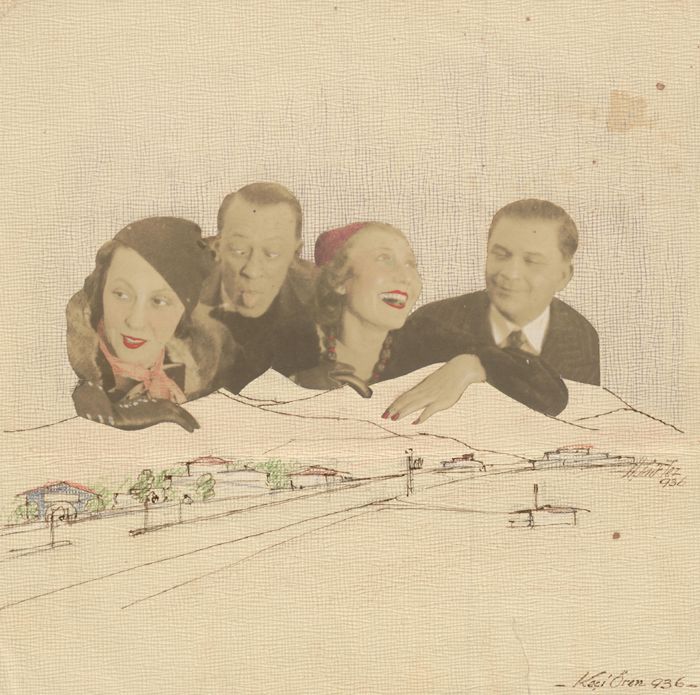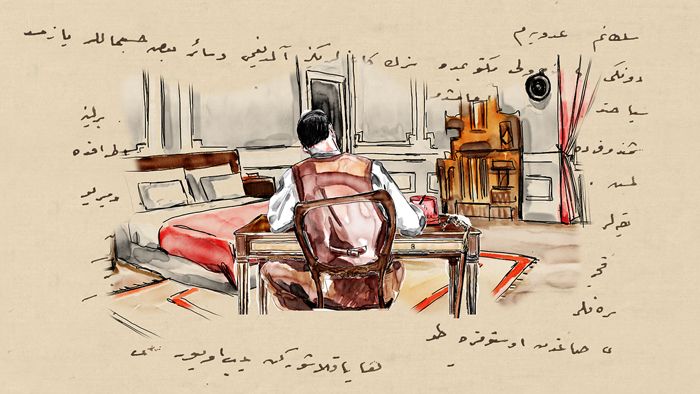Dismantling the Archive:
Representation, Identity, Memory
in an Ottoman Family
Salt Galata
January 21 – March 30, 2014

Collage by Said Bey’s son Hakkı Tez
1936, Keçiören
SALT Research, Said Bey Archive
1936, Keçiören
SALT Research, Said Bey Archive
“To produce a life history or to consider life as a history, that is, as a coherent narrative of a significant and directed sequence of events, is perhaps to conform to a rhetorical illusion.” Pierre Bourdieu
Dismantling the Archive: Representation, Identity, Memory in an Ottoman Family follows the idea that the story of a life is like an archive, a mass of constructed and filtered events that are unconnected to one another, random, irrational. It focuses on the years 1900-1940 of the Said Bey Archive, donated by Hatice Gonnet Bağana to SALT Research, encompassing three generations from the late Ottoman period up through the early years of the Republic of Turkey.
The exhibition attempts to understand how a family, as it passed through a complicated process of transition, expressed and represented itself in writing, photography, music, narratives, and material culture. It goes on to explore how family memories became intertwined with the national narrative of the young republic still in the process of formation, and how the family constructed their own identities by delineating social and class boundaries.
The exhibition aims to probe the possibilities and limitations of biographical and historiographical investigation and to make these disciplines as transparent as possible. It emphasizes the word “dismantling”, the antithesis of the integrity, order, isolation, and privacy typically attributed to archives and to biography.
Dismantling the Archive is not simply a historical and archival exhibition: it is also an exhibition on historiography and archivism and is itself an essay in historiography.

Said Bey writing letters to his wife Adviye Hanım when he was in Berlin, June 1911
Illustrated by Sait Mingü, 2013
Animated by Boran Güney, 2013
Illustrated by Sait Mingü, 2013
Animated by Boran Güney, 2013
About Said Bey
Mehmed Said Bey (1865-1928) was a graduate of the Imperial School, today’s Galatasaray High School, and he went on to teach there in addition to working as an interpreter at the Ottoman palace. In the words of the French historians François Georgeon and Paul Dumont, he was a veritable “caricature of a bourgeois Istanbulite”: there was a piano in his home; every day he noted down what he had done in his diary; he enjoyed going to the cinema; he arranged for his children to be taught French by a young mademoiselle; and in the 1920s he and his family moved to an apartment in the Şişli district.
The project was conceptualized by Ece Zerman based on her master thesis and later developed as part of SALT’s “Open Archive” series. The exhibition design is by Future Anecdotes Istanbul.
Ottoman transcription: Sinem Gülmez
French translations: Noémi Lévy Aksu
English translations: R. Aslıhan Aksoy Sheridan, Michael D. Sheridan
Illustration: Sait Mingü
Animation: Boran Güney
Mehmed Said Bey (1865-1928) was a graduate of the Imperial School, today’s Galatasaray High School, and he went on to teach there in addition to working as an interpreter at the Ottoman palace. In the words of the French historians François Georgeon and Paul Dumont, he was a veritable “caricature of a bourgeois Istanbulite”: there was a piano in his home; every day he noted down what he had done in his diary; he enjoyed going to the cinema; he arranged for his children to be taught French by a young mademoiselle; and in the 1920s he and his family moved to an apartment in the Şişli district.
The project was conceptualized by Ece Zerman based on her master thesis and later developed as part of SALT’s “Open Archive” series. The exhibition design is by Future Anecdotes Istanbul.
Ottoman transcription: Sinem Gülmez
French translations: Noémi Lévy Aksu
English translations: R. Aslıhan Aksoy Sheridan, Michael D. Sheridan
Illustration: Sait Mingü
Animation: Boran Güney

